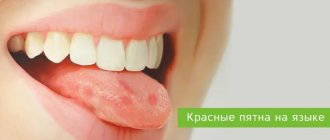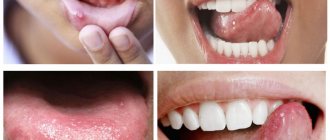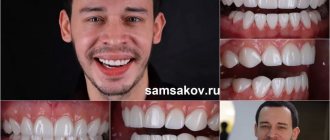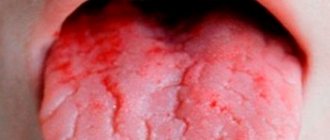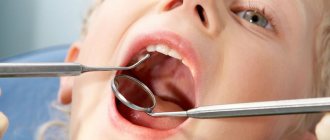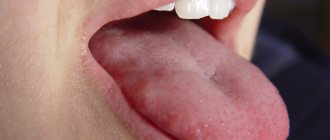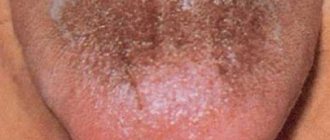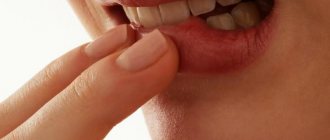Types of acquired red moles on the body
- Simple (capillary). Proliferation of newly formed capillaries, small venous and arterial vessels. Looks like a red spot.
- Cavernous. A spongy cavity with blood - a red or bluish nodule. Often forms under the skin.
- Branched (racellose). A plexus of tortuous dilated capillary trunks. They pulsate, noise and trembling are detected. It is rare and occurs on the extremities or face. If injured, life-threatening bleeding may occur.
How to identify hemangioma? Press on top of it and it should fade or disappear.
The main causes of a blood blister
The general condition and integrity of the oral mucosa usually indicates the level of health of the body. Often, by examining the appearance of the oral mucosa and blisters, the doctor makes a final diagnosis. After all, the symptoms of most infectious, bacterial, chronic, and acute processes that occur in the body are associated with changes in the integrity and color of the oral mucosa. Therefore, it is important to understand the main reasons that cause blood blisters to appear in the mouth.
Blood blisters are distinguished by the place of their occurrence - on the tongue, under the tongue, on the cheek. They can occur as a result of injury or be a signal of the presence of a serious disease in the body. Multiple blood blisters on the oral mucosa occur with stomatitis, diseases of the gastrointestinal tract, and disturbances in the functioning of the endocrine system. The cause of the sudden appearance of a blood bubble in the mouth is damage to the mucous membrane.
There are the following types of injuries to the oral cavity:
- mechanical injury.
The cause may be various objects, solid food, biting the cheek; - chemical injury.
It occurs due to the consumption of spicy, salty foods, and exposure to chemicals on the mucous membrane. This irritates the delicate oral mucosa and causes injury; - thermal injuries.
Their appearance is provoked by too cold or hot food or drinks.
Are red moles dangerous?
In themselves, these formations are harmless and are not precancers.
If you have a lot of red moles on your body, the cause may be a serious liver or pancreas disease. Pay attention to this - this is a reason for examination.
Problems may arise in case of traumatization of hemangiomas. Even fairly small formations threaten heavy bleeding, which is not easy to stop.
Clinical case
Patient L, 26 years old, presented with a traumatized mass in the axillary region. According to her, she tore off a convex hemnagioma with the edge of a rigid corset of a wedding dress almost a few minutes before the start of the wedding ceremony. The hemangioma bled very heavily and a large blood stain appeared on her white dress. She had to wear the witness's jacket over her wedding dress. It was in such a strange outfit that the wedding took place.
Blood blisters
The cheeks, due to their vital importance, are well protected, this is how it happened evolutionarily. Therefore, the muscle and mucous tissue of the cheeks are well innervated and richly vascularized, that is, supplied with blood. However, it also happens that this seemingly useful process becomes a problem. Many people are faced with the fact that a blood ball appears in the mouth on the mucous membrane of the cheek. Often such formation does not foreshadow anything dangerous. A blood bubble that forms in the mouth on the cheek is just the result of a mechanical injury. Most likely, the cheek area was bitten by the teeth while eating or talking. Since the oral cavity is a complex biological system in which a huge number of microorganisms live, it is natural that when such a microtrauma occurs, it becomes contaminated with various kinds of pathogens. As a result, a whole cascade of body responses is activated:
- since the pathogen is a foreign substance in the inner layer of the cheek, the immune system is immediately activated. Leukocytes, monocytes and macrophages quickly arrive at the site of infection, capture the pathogen and destroy it, and often die themselves;
- due to the death of immune cells that have absorbed pathogenic microflora, their internal contents are released into the environment. These biologically active substances are chemotaxis factors, that is, they signal to other cells, as a result of which substances such as histamine, serotonin, bradykinin - inflammatory mediators - are released in the area of inflammation;
- inflammatory mediators cause spasm of the circulatory system, which makes blood flow difficult; and after some time the vessels relax, and all the blood that has accumulated at the site of narrowing immediately flows into the source of inflammation. Since such blood flows at high speed and under high pressure, it forms a detachment of the mucous membrane - a bubble - and a blood ball appears in the mouth.
Thus, the blood blisters that form in the mouth are just part of the body's defense mechanism, which has been formed over centuries. When such a pathology appears, you should not panic too much. Regular blood blisters reorganize on their own within 3-4 days. But if the blood bubble does not self-destruct within a week, consult a dentist to rule out the diagnosis of unwanted neoplasms. The doctor will not only prescribe a pain reliever (since the appearance of a neoplasm on the mucous membrane is sometimes accompanied by pain), but will also take a sample of the epithelium for histology analysis.
Additional measures to prevent hematomas
To reduce the risk of blood balloons swelling on the oral mucosa, patients are advised to follow a few simple rules:
- avoid salty and spicy foods that irritate the mucous membranes;
- adjust the design of prostheses and orthopedic systems for the jaw apparatus;
- increase the amount of medium-temperature liquid and semi-liquid foods in the diet
We should also not forget about the need to regularly visit the dentist for the timely detection and elimination of diseases of the teeth and gums. This solution will help maintain oral health and avoid a number of serious pathologies with unpleasant symptoms.
Causes of a blood ball in the mouth
Most often, a blood ball in the mouth is formed under the influence of external irritants and periodically, less often, is chronic. If there is an infection (viral or bacterial), the mucous membrane in the oral cavity also changes, which can lead to the formation of a ball. If it is present, depending on the size, a person feels acute pain when eating food with acid, drinking juices or plain water.
Main reasons:
- mechanical - biting the cheek or hard food can disrupt the integrity of the oral cavity, and since there is a large number of bacteria in the mucous membrane, a ball forms or this place becomes inflamed
- thermal - burn from hot or cold food
- chemical - food that is too salty or seasoned with spices disrupts the mucous membrane in the oral cavity, which can lead to the formation of a ball in different places
- pathological - stomatitis, thrush, tumor, hemangioma, diseases of the gastrointestinal tract or endocrine system - in the case of such pathologies, the mucous membrane is damaged, or rather its protective properties for the oral cavity decrease and wounds, pustules and blood globules form in it
Treatment
It is not necessary to treat blood blisters that form on the buccal mucosa. But if they bother you a lot, then you can puncture such blisters. It is better not to carry out such punctures on your own, especially if you are not sure of the diagnosis, so as not to harm yourself. In addition to punctures, you can rinse the mouth with antiseptic solutions - for example, chlorhexidine, furatsilin; You can use oral baths with decoctions of chamomile herbs or oak bark - these solutions will relieve local signs of inflammation. In addition to all this, it is believed that the development of such blood blisters occurs due to the weakness and fragility of the blood vessels. To strengthen the walls, you can use B vitamins, vitamin A, E, K, C inside. It will not hurt to stimulate and maintain the immune system, especially in the off-season, when the supply of micro- and macroelements to the body is reduced. Complex multivitamin preparations, which already contain all the necessary substances in the required quantities, are perfect for such purposes.
Causes of hematoma formation on the oral mucosa
The general scheme of hematoma formation is as follows: a rupture of a vessel causes the leakage of a certain amount of blood, followed by its compaction and the appearance of a blood clot. A bubble forms, noticeable on the smooth surface of the mucosa due to its dark coloring and relief. Often a similar picture can be observed during teething, when the gums bleed and become inflamed. The formation of multiple small hematomas, covering the entire surface of the mucous membrane in the mouth with unattractive dark spots, looks very unpleasant for the patient. But don’t panic if you suspect you have a serious illness. As practice shows, most of these phenomena occur due to mechanical trauma to the mucous membrane. But there are exceptions when the symptom indicates:
- allergic reaction;
- chronic injury;
- consequences of stressful situations;
- burns or cuts to the mucous membrane.
There have also been cases when multiple hematomas in the oral cavity are signs of:
- diabetes mellitus;
- hypertension;
- renal failure;
- complex types of stomatitis;
- blood diseases;
- vitamin deficiency, which causes fragility of blood vessels.
The exact cause and stage of formation of the pathology can only be determined after a thorough examination and diagnosis. For this reason, you should not self-medicate, so as not to further injure damaged tissues.
Symptoms of hematomas in the oral cavity
The most noticeable sign is the spread of vesicles with bloody contents throughout the mucosa. Often there are no other symptoms of pathology. Sometimes patients complain of itching and tingling in the area of damaged tissue. Doctors say that this is a reaction to additional chemical and mechanical irritation of the inflamed mucous membrane under the influence of saliva, contact with teeth, etc. When hematomas form on the oral mucosa during tooth eruption, there are sensations of bursting and pressure from within the gum tissue. If inflammation has become a complication of a burn, pain is a logical consequence of mechanical irritation of the mucous membrane.
Signs of the appearance of blood balls on the cheeks in the mouth, requiring immediate examination and diagnosis, are included in a separate group. Among them:
- relatively frequent appearance of a large number of points of inflammation;
- the duration of wound healing, despite the measures taken to treat them;
- hematomas that are too large, interfering with eating and full communication;
- formation of bloody balls on the lips.
Each of these signs can be a symptom of serious disorders in the body. Therefore, the optimal solution would be to refuse self-medication and schedule a consultation with a qualified dentist.
